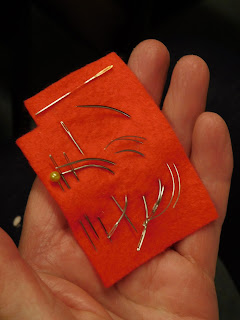Lyn showed us her beautiful stitch book, with stitch examples, how they could be used in various shapes and then how a variety of stitches were used together to create an image. She had brought cotton fabric for the book leaves, thread and needles, so there was no excuse not to stitch. It was a delightful light hearted evening, enjoyed by all present.
Sunday, 30 April 2017
Sunday, 23 April 2017
Wednesday day of stitch with Lyn Rochester 5th April 2017
The
day was open to all members to create heart cushions and items to sell in the
Lincolnshire show.
We
made stuff heart shaped cushions – to be donated to the hospital to give to
women who have had a mastectomy; the idea is that they tuck it under their arm
to stop their arm rasping the surgical cut. I only made one heart cushion, but
it was very soft and nice. Others had made many more and a couple finished them
off that day.
During
the day I managed to make five pea pod brooches with fleece and felt to sell at
the Lincolnshire show. Judith our secretary had produced huge numbers of pieces
for sale.
We
were given lunch to keep us going – a lovely vegetable soup (made by Lyn’s
husband John) and a range of amazing cheeses.
Sunday, 16 April 2017
Lyn Rochester - Fowers, Leaves and Insects - Stitch Club 15/4/2017
Lyn brought several examples of her own work, including her Green Man (decorated with many insects) just returned from the Capability Brown exhibition.
Most of us focused on the leaves, despite her delicious depictions of dandelions and sweetpeas. Lyn has a wide selection of cardboard template leaves she had made from her collection of dried real leaves. We had a good selection of fabrics Lyn had dyed herself to choose from. She suggested that we embroider our leaves before cutting the fabric - that being less fiddly. Thanks to Anne and Monika an iron was available to use on bondaweb. The stitch club Bailgate members were joined by three IMPart members, which was delightful.
Sunday, 9 April 2017
Anne Goodall's outings April 2017
I’ve treated myself to two outings in the last two weeks,
both very worthwhile. Last week, after seeing the page on Facebook I drove down
to Digby Fen to have a look at Spindle Cottage Workshop. (NB to anyone who might
try to find it: just use the postcode, LN4 4DT, and be aware that this code is
shared by all the - very scattered – residences on Allens Lane. None of them
have numbers, so its a matter of driving slowly past each, looking out for their
sign; its on the north side of the road. Opening hours 10-4 Tues-Fri, 10-1
Sat.) The Workshop is an L-shaped building – put up for Georgina, the owner, by
her obviously very useful husband – with the workshop area occupying the foot of
the L, where there are tables, big windows and of course the important fridge,
sink and kettle. The long upright is the treasure trove of everything for
patchwork and quilting mainly, though it caters for everything else you might
need cotton fabric for. I couldn’t resist buying of course, but choosing is the
difficulty; talk about spoilt for choice... She also has a programme of approx.
weekly workshops, from absolute beginners to the more experienced who want to
try something different. I recognised some of the names of the people who run
these, and I just might be tempted!
Then yesterday, closer to home, I went to see the ImpART
Spring Fair, at the Methodist Church on St Rumpoles Street – free parking too.
(Partly lured there by Kate’s promise of cakes, and cakes there were, including
a very interesting gluten-free fruit cake/teabread, which was delicious, and
very fruity.) Sadly the Fair wasn’t very well attended, and it deserved to be,
since its clear a lot of hard work had gone into every stall. I acquired a
lovely crocheted shawl cum throw, which is just as warm as advertised, and is
going to be worn a lot on cooler evenings this summer.
Friday, 7 April 2017
Textile Conservation - a talk by Leah Warriner-Wood Friday evening 31st march 2017
Leah was involved with Doddington hall tapestries; they were
stitched onto a support layer and Velcro was used to hang them. This is so that
it is easy to pull the tapestries down and throw them out of the window if
there is a fire.
Her conservation remit is to ask what is it? What is it made
of? How is it made? How was it used?
In the distant past clothes were cleaned with bread and lace
with milk. Nowadays in conservation there is minimal intervention, just so it
can survive and be displayed. Laying in distilled water with a mild liquid soap,
waiting for the dirt to shift is the most that takes place regarding cleaning;
about three repeats removes the dirt.
She uses most of the time curved John James needle 10 and
Gutterman polyester threads.
Subscribe to:
Comments (Atom)









